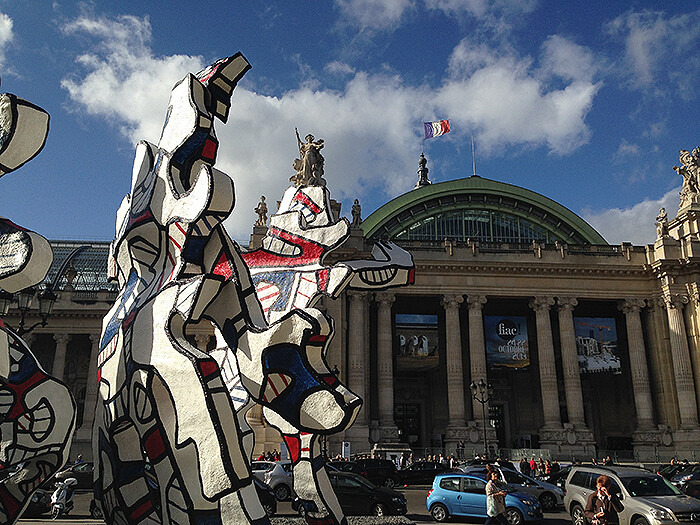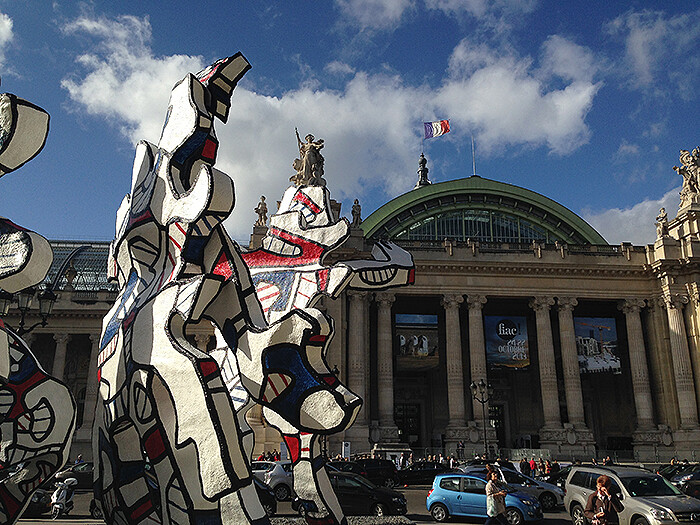Turning forty is tough. But FIAC is celebrating this milestone in characteristic Parisian style with a slightly more international roster of galleries on view in the Grand Palais (with first-timers from Canada, Ireland, and the Czech Republic). And with an expanded and notably strong “Hors les Murs” (Outside the Walls) program this year, the metaphorical birthday party is reaching a wider public audience and taking over more Paris real estate than ever before. Indeed part of what makes this year’s fair particularly strong is the synergy between what’s for sale inside the fair booths and what’s on view elsewhere in the Parisian art scene.
Beyond representing nearly 30% of the booths at FIAC, local galleries—surely anticipating a rush of international visitors—tend to plan their best shows for October (Omer Fast at gb agency, Abraham Cruzvillegas at Galerie Chantal Crousel, Aaron Curry at Almine Rech Gallery). In addition, the fair’s sprawling “Hors les Murs” spotlights the city’s cultural institutions, public gardens, and historic monuments. This fall, these satellite presentations range from a large Jean Dubuffet sculpture, Welcome Parade (2008 [based on a maquette from 1974]), installed in front of the Petit Palais, to the first-ever Parisian showcase of the entrepreneur François Pinault’s mega-collection of contemporary art at the Conciergerie, a former prison. Add major solo shows dedicated to two of France’s most renowned contemporary artists—Pierre Huyghe and Philippe Parreno at the Centre Pompidou and Palais de Tokyo, respectively—and you have a recipe for a buzz-worthy “only-in-Paris” art moment.
Uncharacteristic blue skies and unseasonably warm weather made for a jovial atmosphere inside the soaring sky-lit Grand Palais during FIAC’s vernissage on Wednesday. Emphasizing the greenhouse-like ambiance of the exhibition hall’s Beaux-Arts iron-and-glass architecture, Ai Weiwei’s enormous Iron Tree (2013), presented by Berlin’s neugerriemschnedier, greeted fairgoers inside the main entrance. By far the tallest thing around, the widely splayed branches jutting out from a thick and gnarled trunk can be seen from virtually everywhere—making it a useful means of orientation inside the maze of booths.
Beyond acting as a de facto landmark, Iron Tree also introduces the first of several trends to be found at the fair. Other massive sculptures evoking natural materials—think wood grain and rough edges as opposed to shiny metals and glossy plastics—include Better Knowing (2013), a KAWS sculpture of a seated girl in buffed, multi-toned wood at Galerie Perrotin (now in Paris, Hong Kong, and New York) and a rough-cut figure Volk Ding Zero – Folk Thing Zero (2009) by Georg Baselitz, which looks like wood, but is actually painted bronze, at Galerie Thaddaeus Ropac, Paris/Salzburg. Less grandiose, but similarly organic in spirit are: La possession du monde n’est ma priorité (2013), a curious collection of rocks and corals by Théo Mercier at Galerie Gabrielle Maubrie’s booth (a solo presentation of his work is also on view at their Paris gallery); Carsten Höller’s Giant Triple Mushroom (2012) at Massimo de Carlo, Milan/London; and Gilles Barbier’s Still Memory 8 (2013), a paperback tower ensconced by verdant overgrowth at the booth of Galerie Georges-Philippe & Nathalie Vallois, which also features Barbier’s work in a solo show at their local gallery space.
Stand out solo booths on the main level include Laura Owens at Gavin Brown’s enterprise, New York, Gabriel Kuri at Sadie Coles HQ, London, and Serge Poliakoff at Applicat-Prazan, Paris—which coincides with the Russian modernist’s current retrospective at the Musée d’Art moderne de la Ville de Paris (MaM). Also promoting an artist with a current solo show in Paris, Air de Paris has two works from Philippe Parreno’s series “Fade to Black”—silkscreened images in phosphorescent ink on neon paper, which are only visible in the dark—that are prominently featured in his current Palais de Tokyo exhibition. Further down the same aisle, Berlin heavy-hitter Esther Schipper is showing Pierre Huyghe’s golden tap shoes on a scuffed pedestal, Singing in the Rain (1996), part of an edition of three that is also included in his Pompidou show. A less direct echo of yet another recently opened Paris exhibition (MaM’s “Decorum,” which focuses on contemporary artists working with weavings and tapestries) are the numerous textile-based offering on view at the fair. To name just a few: Kiki Smith at Milan’s Galleria Raffaella Cortese; Louis Cane at Galerie Bernard Ceysson, Geneva; Louise Bourgeois at Hauser & Wirth (Zürich, London, New York); and Ulla von Brandenburg at Art Concept, Paris.
As usual the galleries on the upper level cultivate a more playful, cool-kids vibe. In the “Salon d’Honneur,” staff and friends of Paris’s Galerie Balice Hertling and Milan’s Giò Marconi, who are sharing a booth, lounged on a large pillow Banana with Four Peels (2012) by Nathalie Djurberg next to a Sam Falls’s bedframe-mounted, clothesline-dried Untitled (Queen 4, Hartland VT) (2013). Around the corner in the “Secteur Lafayette,” local Semiose galerie presented Julien Tiberi and Aurélien Mole’s Sir Thomas Trope (2013), a giant “wonder turner,” or Victorian-era toy also known as a thaumatrope. Fairgoers can spin the freestanding wall, which is adorned with various flat, three-dimensional and articulated works.
Complementing the references to the natural world found inside the Grand Palais, FIAC’s “Hors les Murs” program effectively projects the fair onto Paris’s quays, gardens, and plazas. Introducing this year’s projects at the Jardin des Plantes last Friday, FIAC director Jennifer Flay described how temporary public artworks underline art’s relationship with nature and introduce the general public to unexpected contemporary art. While these noble aspirations are certainly valid, there is an undeniable commercial aspect to the undertaking as well. For sale themselves, these outdoor artworks also act as (charismatic) billboards for the fair and its wares. Impressed by artist Didier Faustino’s installation of metal barricades on view in the Jardin des Tuileries? You’ll find The Wild Thing (2011), a more manageable Faustino mobile, in the booth of Galerie Michel Rein, Paris/Brussels. Can’t accommodate a Tadashi Kawamata “Tree Hut” like those perched around Place Vendôme? Check out the artist’s scale model Camargue project (Museum Camargue) n°4 (2013) at the booth of Parisian galerie kamel mennour. And so on… Considered in this respect, “Hors les Murs” seems to offer a home court advantage. Tending to be quite massive (i.e., cumbersome and expensive to transport), the majority of artworks scattered across the city are presented by local galleries.
In the Jardin des Plantes, for example, ten of the fourteen outdoor sculptures are credited to Parisian galleries. Works on view here range from sculptures similar to what one might expect to find in family-friendly Parisian gardens—Erik Dietman’s Untitled (Frère de Dieux) (2002), an abstract self-portrait in bronze presented by Claudine Papillon Galerie, Paris—to more outrageous pieces like Richard Jackson’s 2011 bubblegum-pink Little Girl and Upside Down Unicorn from Galerie Georges Philippe & Natalie Vallois, Paris. Balancing out the bling are ephemeral offerings like Walking backwards (2013), a guided private tour of the Jardin Écologique organized by Paris-based artist Alex Cecchetti, which was offered for a few hours only, on a drizzly afternoon before the official opening of the fair. Walking haltingly in reverse, as I followed my guide’s voice—which described the history of the garden and a legend about a princess and a supposedly aphrodisiacal berry—was the point when I felt furthest from the commercial hustle of the fair.
Business aside, the “Hors les Murs” projects enrich FIAC by showcasing another facet of the contemporary art scene while invigorating Paris’s physical and cultural landscape. Because artists and galleries must make proposals for specific locations, there is less so-called “plop art” and more works that engage (formally or conceptually) with their temporary sites. Clément Borderie’s Page Blanche (2013), for instance, will collect dust and debris over the course of several weeks along the banks of the Seine. And James Lee Byars’s gleaming orb The Golden Sphere (1992–2012), which floats in one of the Tuileries fountains, dialogues with the golden tip of the famous Luxor Obelisk at Place de la Concorde.
Describing the desire to reach a wider audience, Philippe Jousse—whose Parisian gallery Jousse Enterprise has an impressive five projects in this year’s “Hors les Murs,” including a stunning untitled Francisco Sobrino column from 1967–71, made of highly reflective steel squares—commented, “A collector could easily plan to see Sobrino’s work in the Jardin des Tuileries, but I like the idea that flâneurs will discover these works while simply enjoying the gardens.” Weighing in with the artist’s perspective, Johan Creten—whose bronze eagle/cormorant hybrid, Pliny’s Sorrow sur la Colonne (2011) is on view in the Jardin des Plantes—described the aesthetic experience of art en plein air: “Showing the work in relationship to nature, in a beautiful park with natural light glinting off the surface and the sky behind it, creates a different emotion and a different sense of scale—this is the beauty of artwork outside of the white cube!” Likewise, part of the beauty of FIAC is that it encompasses both private and public realms of the art world, which are often segregated, especially at fairs. Fresh air does a fair good!
















